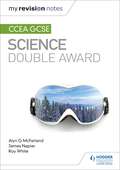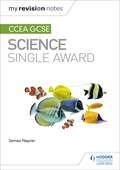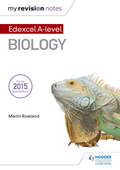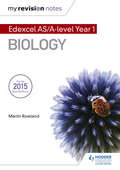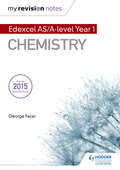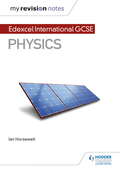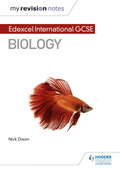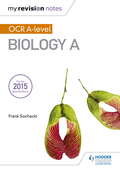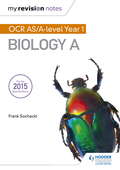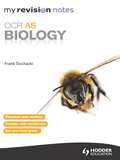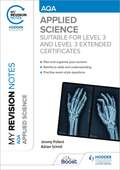- Table View
- List View
My Revision Notes: CCEA GCSE Physics
by Roy Whitearget success in CCEA GCSE Chemistry with this proven formula for effective, structured revision; key content coverage is combined with exam-style tasks and practical tips to create a revision guide that students can rely on to review, strengthen and test their knowledge.With My Revision Notes, every student can:- Plan and manage a successful revision programme using the topic-by-topic planner- Consolidate subject knowledge by working through clear and focused content coverage- Test understanding and identify areas for improvement with regular 'Now Test Yourself' tasks and answers- Improve exam technique through practice questions, expert tips and examples of typical mistakes to avoid- Answers to the practice questions available online
My Revision Notes: CCEA GCSE Physics
by Roy Whitearget success in CCEA GCSE Chemistry with this proven formula for effective, structured revision; key content coverage is combined with exam-style tasks and practical tips to create a revision guide that students can rely on to review, strengthen and test their knowledge.With My Revision Notes, every student can:- Plan and manage a successful revision programme using the topic-by-topic planner- Consolidate subject knowledge by working through clear and focused content coverage- Test understanding and identify areas for improvement with regular 'Now Test Yourself' tasks and answers- Improve exam technique through practice questions, expert tips and examples of typical mistakes to avoid- Answers to the practice questions available online
My Revision Notes: CCEA GCSE Science Double Award
by James Napier Roy White Alyn G. McFarlandTarget success in CCEA GCSE Double Award Science with this proven formula for effective, structured revision; key content coverage is combined with exam-style tasks and practical tips to create a revision guide that students can rely on to review, strengthen and test their knowledge.With My Revision Notes, every student can:- Plan and manage a successful revision programme using the topic-by-topic planner- Consolidate subject knowledge by working through clear and focused content coverage- Test understanding and identify areas for improvement with regular 'Now Test Yourself' tasks and answers- Improve exam technique through practice questions, expert tips and examples of typical mistakes to avoid- Answers to the practice questions available online
My Revision Notes: CCEA GCSE Science Double Award
by James Napier Roy White Alyn G. McFarlandTarget success in CCEA GCSE Double Award Science with this proven formula for effective, structured revision; key content coverage is combined with exam-style tasks and practical tips to create a revision guide that students can rely on to review, strengthen and test their knowledge.With My Revision Notes, every student can:- Plan and manage a successful revision programme using the topic-by-topic planner- Consolidate subject knowledge by working through clear and focused content coverage- Test understanding and identify areas for improvement with regular 'Now Test Yourself' tasks and answers- Improve exam technique through practice questions, expert tips and examples of typical mistakes to avoid- Answers to the practice questions available online
My Revision Notes: CCEA GCSE Science Single Award
by James NapierTarget success in CCEA GCSE Single Award Science with this proven formula for effective, structured revision; key content coverage is combined with exam-style tasks and practical tips to create a revision guide that students can rely on to review, strengthen and test their knowledge.With My Revision Notes, every student can:- Plan and manage a successful revision programme using the topic-by-topic planner- Consolidate subject knowledge by working through clear and focused content coverage- Test understanding and identify areas for improvement with regular 'Now Test Yourself' tasks and answers- Improve exam technique through practice questions, expert tips and examples of typical mistakes to avoid- Answers to the practice questions available online
My Revision Notes: CCEA GCSE Science Single Award
by James NapierTarget success in CCEA GCSE Single Award Science with this proven formula for effective, structured revision; key content coverage is combined with exam-style tasks and practical tips to create a revision guide that students can rely on to review, strengthen and test their knowledge.With My Revision Notes, every student can:- Plan and manage a successful revision programme using the topic-by-topic planner- Consolidate subject knowledge by working through clear and focused content coverage- Test understanding and identify areas for improvement with regular 'Now Test Yourself' tasks and answers- Improve exam technique through practice questions, expert tips and examples of typical mistakes to avoid- Answers to the practice questions available online
My Revision Notes: Edexcel A Level Biology B
by Martin RowlandWith My Revision Notes you can:- Manage your own revision with step-by-step support from experienced teacher and examiner Martin Rowland- Apply biological terms accurately with the help of definitions and key words- Plan and pace your revision with the revision planner- Test understanding with questions throughout the book- Get exam ready with last minute quick quizzes available on the Hodder Education website
My Revision Notes: Edexcel A Level Chemistry
by George FacerWith My Revision Notes you can:- Manage your own revision with step-by-step support from experienced teacher and examiner George Facer- Apply biological terms accurately with the help of definitions and key words- Plan and pace your revision with the revision planner- Test understanding with questions throughout the book- Get exam ready with last minute quick quizzes available on the Hodder Education website
My Revision Notes: Edexcel A Level Chemistry
by George FacerExam Board: EdexcelLevel: AS/A-levelSubject: ChemistryFirst Teaching: September 2015First Exam: June 2017With My Revision Notes you can:- Manage your own revision with step-by-step support from experienced teacher and examiner George Facer- Apply biological terms accurately with the help of definitions and key words- Plan and pace your revision with the revision planner- Test understanding with questions throughout the book- Get exam ready with last minute quick quizzes available on the Hodder Education website
My Revision Notes: Edexcel AS Biology B
by Martin RowlandUnlock your full potential with My Revision Notes: expert guidance on how to apply the key content you need to know.With Edexcel AS Biology you will be able to:-Take control of your revision - plan and focus on the areas where you need to improve your knowledge and understanding with advice, summaries and notes from expert author Martin Rowland-Achieve your potential - make accurate and effective use of biological terms and concepts with the help of key words and definitions on all topics- Improve your exam skills - tackle a range of exam-style and test yourself questions in the book, plus last-minute quick quizzes at www.hoddereducation.co.uk/myrevisionnotes
My Revision Notes: Edexcel AS Chemistry
by George FacerUnlock your full potential with My Revision Notes: expert guidance on how to apply the key content you need to know.With Edexcel AS Chemistry you will be able to:- Take control of your revision - plan and focus on the areas where you need to improve your knowledge and understanding with advice, summaries and notes from expert author George Facer- Achieve your potential - make accurate and effective use of chemical terms and concepts with the help of key words and definitions on all topics- Improve your exam skills - tackle a range of exam-style and test yourself questions in the book, plus last-minute quick quizzes at www.hoddereducation.co.uk/myrevisionnotes
My Revision Notes: Edexcel AS Chemistry
by George FacerUnlock your full potential with My Revision Notes: expert guidance on how to apply the key content you need to know.With Edexcel AS Chemistry you will be able to:- Take control of your revision - plan and focus on the areas where you need to improve your knowledge and understanding with advice, summaries and notes from expert author George Facer- Achieve your potential - make accurate and effective use of chemical terms and concepts with the help of key words and definitions on all topics- Improve your exam skills - tackle a range of exam-style and test yourself questions in the book, plus last-minute quick quizzes at www.hoddereducation.co.uk/myrevisionnotes
My Revision Notes: Edexcel International GCSE (MRN)
by Ian HorsewellTarget success in Edexcel International GCSE Physics with this proven formula for effective, structured revision; key content coverage is combined with exam-style tasks and practical tips to create a revision guide that students can rely on to review, strengthen and test their knowledge.- Plan and manage a successful revision programme using the topic-by-topic planner - Consolidate subject knowledge by working through clear and focused content coverage - Test understanding and identify areas for improvement with regular 'Now Test Yourself' tasks and answers - Improve exam technique through practice questions, expert tips and examples of typical mistakes to avoid - Get exam ready with extra quick quizzes and answers to the practice questions available online
My Revision Notes: Edexcel International GCSE (MRN)
by Neil DixonTarget success in Edexcel International GCSE Chemistry with this proven formula for effective, structured revision; key content coverage is combined with exam-style tasks and practical tips to create a revision guide that students can rely on to review, strengthen and test their knowledge. - Plan and manage a successful revision programme using the topic-by-topic planner - Consolidate subject knowledge by working through clear and focused content coverage - Test understanding and identify areas for improvement with regular 'Now Test Yourself' tasks and answers - Improve exam technique through practice questions, expert tips and examples of typical mistakes to avoid - Get exam ready with extra quick quizzes and answers to the practice questions available online
My Revision Notes: Edexcel International GCSE (MRN)
by Nick DixonTarget success in Edexcel International GCSE Biology with this proven formula for effective, structured revision; key content coverage is combined with exam-style tasks and practical tips to create a revision guide that students can rely on to review, strengthen and test their knowledge. - Plan and manage a successful revision programme using the topic-by-topic planner - Consolidate subject knowledge by working through clear and focused content coverage - Test understanding and identify areas for improvement with regular 'Now Test Yourself' tasks and answers - Improve exam technique through practice questions, expert tips and examples of typical mistakes to avoid - Get exam ready with extra quick quizzes and answers to the practice questions available online
My Revision Notes: OCR A Level Biology A
by Frank SochackiWith My Revision Notes: OCR A Level Biology A you can:- Manage your own revision with step-by-step support from experienced teacher and examiner Frank Sochacki- Apply biological terms accurately with the help of definitions and key words- Plan and pace your revision with the revision planner- Test understanding with questions throughout the book- Get exam ready with last minute quick quizzes available on the Hodder Education website
My Revision Notes: OCR A Level Biology A (My Revision Notes)
by Frank SochackiExam Board: OCRLevel: A-LevelSubject: BiologyFirst Teaching: September 2015First Exam: Summer 2016With My Revision Notes: OCR A Level Biology A you can:- Manage your own revision with step-by-step support from experienced teacher and examiner Frank Sochacki- Apply biological terms accurately with the help of definitions and key words- Plan and pace your revision with the revision planner- Test understanding with questions throughout the book- Get exam ready with last minute quick quizzes available on the Hodder Education website
My Revision Notes: OCR A Level Chemistry A
by Mike SmithWith My Revision Notes: OCR A Level Chemistry A you can:- Manage your own revision with step-by-step support from experienced teacher and examiner Mike Smith- Apply biological terms accurately with the help of definitions and key words- Plan and pace your revision with the revision planner- Test understanding with questions throughout the book- Get exam ready with last minute quick quizzes available on the Hodder Education website
My Revision Notes: OCR AS Biology A Second Edition
by Frank SochackiWith My Revision Notes you can:- Manage your own revision with step-by-step support from experienced teacher and examiner Frank Sochacki- Apply biological terms accurately with the help of definitions and key words- Plan and pace your revision with the revision planner- Test understanding with questions throughout the book- Get exam ready with last minute quick quizzes available on the Hodder Education website
My Revision Notes: OCR AS Biology ePub
by Frank SochackiGet the best grades with My Revision Notes: OCR AS Biology.Manage your own revision with step-by-step support from experienced teacher and examiner Frank SochackiUse specific examples and advice to improve your knowledge of biological processes and applicationsGet the top marks by applying biological terms accurately with the help of definitions and key wordsImprove your exam skills with self-testing and exam-style questions and answersMy Revision Notes will help you prepare for the big day:Plan and pace your revision with My Revision PlannerUse the concise notes to revise the essential informationUse the examiner's tips and summaries to clarify key pointsAvoid making typical mistakes with expert adviceTest yourself with end-of-topic questions and answers and tick off each topic as you complete itPractise your exam skills on exam questions then check your answers onlineGet exam-ready with last-minute quick quizzes at www.therevisionbutton.co.uk/myrevisionnotes
My Revision Notes: OCR AS Chemistry A Second Edition
by Mike SmithWith My Revision Notes you can:-Manage your own revision with step-by-step support from experienced teacher Mike Smith -Apply chemical terms accurately with the help of definitions and key words-Plan and pace your revision with the revision planner-Test understanding with questions throughout-Get exam ready with last minute quick quizzes available on the Hodder Education website
My Revision Notes: OCR AS/A Level Design and Technology: Product Design
by Julia Morrison Dave Sumpner Simeon ArnoldTarget success in OCR A-level Design and Technology: Product Design with this proven formula for effective, structured revision; key content coverage is combined with exam-style tasks and practical tips to create a revision guide that students can rely on to review, strengthen and test their knowledge.With My Revision Notes every student can:- Plan and manage a successful revision programme using the topic-by-topic planner- Consolidate subject knowledge by working through clear and focused content coverage- Test understanding and identify areas for improvement with regular 'Now Test Yourself' tasks and answers- Improve exam technique through practice questions, expert tips and examples of typical mistakes to avoid
My Revision Notes: OCR GCSE (9-1) Design and Technology
by Andy Knight Kevin Crampton Corinne WalkleyExam board: OCRLevel: GCSESubject: Design and TechnologyFirst teaching: September 2017First exams: Summer 2019Target success in OCR GCSE (9-1) Design and Technology with this proven formula for effective, structured revision. Key content coverage is combined with exam-style tasks and practical tips to create a revision guide that students can rely on to review, strengthen and test their knowledge.With My Revision Notes, every student can:- plan and manage a successful revision programme using the topic-by-topic planner- consolidate subject knowledge by working through clear and focused content coverage- test understanding and identify areas for improvement with regular 'Now Test Yourself' tasks and answers- improve exam technique through practice questions, expert tips and examples of typical mistakes to avoid- get exam ready with extra quick quizzes and answers to the practice questions available online.
My Revision Notes: Suitable for Level 3 and Level 3 Extended Certificates
by Jeremy Pollard Adrian SchmitTarget exam success with My Revision Notes. Our updated approach to revision will help you learn, practise and apply your skills and understanding. Coverage of key content is combined with practical study tips and effective revision strategies to create a guide you can rely on to build both knowledge and confidence.My Revision Notes: AQA Applied Science will help you:- Build quick recall with bullet-pointed summaries at the end of each chapter.- Improve maths skills with helpful reminders and tips accompanied by worked examples.- Practise and apply your skills and knowledge with Exam practice questions and frequent now test yourself questions, and answer guidance online- Develop your subject knowledge by Making links between topics for more in-depth exam answers.- Understand key terms you will need for the exam with user-friendly definitions and a glossary- Avoid common mistakes and enhance your exam answers with Exam tips.- Plan and manage your revision with our topic-by-topic planner and exam breakdown introduction.
My Revision Notes: Suitable for Level 3 and Level 3 Extended Certificates
by Jeremy Pollard Adrian SchmitTarget exam success with My Revision Notes. Our updated approach to revision will help you learn, practise and apply your skills and understanding. Coverage of key content is combined with practical study tips and effective revision strategies to create a guide you can rely on to build both knowledge and confidence.My Revision Notes: AQA Applied Science will help you:- Build quick recall with bullet-pointed summaries at the end of each chapter.- Improve maths skills with helpful reminders and tips accompanied by worked examples.- Practise and apply your skills and knowledge with Exam practice questions and frequent now test yourself questions, and answer guidance online- Develop your subject knowledge by Making links between topics for more in-depth exam answers.- Understand key terms you will need for the exam with user-friendly definitions and a glossary- Avoid common mistakes and enhance your exam answers with Exam tips.- Plan and manage your revision with our topic-by-topic planner and exam breakdown introduction.

